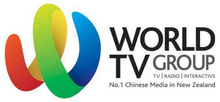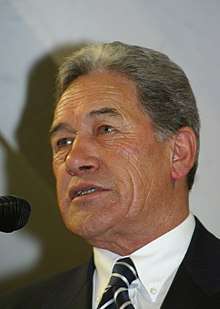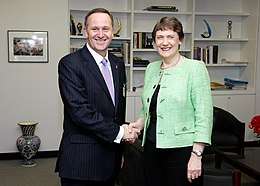World TV
World TV is a New Zealand television, radio and print media company specialising in media for Asian migrants and Asian language communities. It operates two free-to-air television channels on the Freeview platform and three 24-hour radio networks through terrestrial radio and Sky.[1]
| World TV | |
|---|---|
 | |
| Launched | 1 June 2000 (Sky TV channels) 13 August 2007 (UHF) 9 October 2008 (Freeview) |
| Owned by | World TV Limited |
| Picture format | 576i (SDTV) 16:9 |
| Country | New Zealand |
| Language | Standard Chinese Taiwanese Mandarin Cantonese Japanese Korean English |
| Broadcast area | Major centres on Freeview terrestrial Nationwide on Sky |
| Headquarters | Penrose, Auckland, New Zealand |
| Website | wtv.co.nz |
Availability | |
| Terrestrial | |
| Freeview | Channels 28-29 |
| Terrestrial radio | 936 AM 99.4 FM 104.2 FM |
| Satellite | |
| Sky | Channels 311-313 |
The radio stations, AM936, Chinese Radio FM 99.4 and Chinese Radio FM 104.2, broadcast a combination of Hong Kong and Chinese programmes, and local music, parenting and talkback shows.[2]
In December 2005, the company claimed to have 11,500 subscribers across the country for its seven channels of Chinese, Taiwanese and Hong Kong programmes. In 2009, the company claimed 20,000 people received its World TV subscriber magazine.[3] World TV's largest shareholder is Taiwanese resident Fun-nu Tsai with a 19 percent stake; chief executive Henry Ho owns 15 percent of the company and 11 other investors also have shares.[1] The company's income is now evenly shared between advertising and subscription fees.[4]
History
2000-2004

World TV launched in June 2000 to take advantage of the infrastructure and viewing quality of the Sky TV digital platform that had been launched the year before. Through its ongoing partnership with Sky, it has continued to provide entertainment, educational and cultural programming to new migrants, New Zealand-born Chinese New Zealanders and other speakers and learners of standard Mandarin throughout the country. The company's mission has been to help new generations of Asian New Zealanders retain their language and cultural identity through quality programming, up-to-date information, imported entertainment and local community news.[1]
World TV attracted the attention of other media in 2002, for an interview by Rod Peng on the Face to Face programme with New Zealand First leader Winston Peters. Peters claimed most migrants from the past 30 years would agree the volume of new migrants coming into the country could be a cause of "discord, violence and racism". Peters also used the appearance to accuse other media of misrepresenting him as anti-Asian, because of what he called an unprofessional focus on emotions rather than facts. He argued he was instead an advocate for new migrants being settled, employed and integrated in small numbers. Peng described Peters as a "very capable politician" with a "very big communication problem".[5]
Between November 2003 and December 2004, Touch China TV also made an attempt to target Chinese-speaking audiences with a two-hour afternoon slot on music channel C4. A University of Otago study put the station's closure down to its failure to combine local content and Chinese programming in a way that gave it a point of difference to transnational broadcasters geared at new English-as-second-language migrants.[6][7][8]
2004-
The company expanded into radio, setting up Auckland-based radio stations Real Good Life (now Chinese Radio FM 99.4) in 2004, New Supremo (now AM936) in 2004, and Radio 9 (now Chinese Radio FM 104.2) in 2010. In 2004, it set up wholly owned subsidiary Chinese Voice Broadcasting to operate the stations on a day-to-day basis. In 2006, World TV added three channels to serve Korean and Japanese language communities. In August 2007, CTV8, the first 24-hour free-to-air Chinese television channel, joined the service - initially as an analogue channel and later as part of the Freeview line-up.[9]
English-language television channel TV9 began broadcasting on Freeview in February 2012, combining imported programmes with simulcasts of Chinese Radio shows. Chief executive Henry Ho said the introduction of specialist English-language broadcasting was a reflection of growing demand for information about Asia, strengthening trading and cultural ties between Asia and New Zealand, and New Zealanders becoming increasingly interested in Asia.[10]
The Chinese media market is very competitive, despite the closure of several Asian media outlets.[11][12][13] Asia Downunder, the country's only programme specifically targeted towards Asian communities, broadcast on TV One between 1994 and 2008. Limited Chinese programming aired on local Auckland channel Triangle TV in the early 2000s through commercial operation Golden Raindrop TV.
On 19 January 2016 Sky announced the World TV channels 300-309 will cease transmission from 1 March 2016.
Free-to-air television
World TV operates two of the New Zealand free-to-air television channels, transmitted by Kordia via DVB 64-QAM. The company has capacity for up to ten channels, but is planning to only have three or four.[4]
WTV28

WTV28, formerly known as CTV8 ( CTV 八; pinyin bā) is a free-to-air regional television channel in Auckland, New Zealand. It launched in August 2007 on UHF Channel 62 and broadcast 24 hours a day to the Auckland urban region. WTV28 has made history in New Zealand as the first Chinese national television channel to be launched. The channel was later made available nationwide via Freeview UHF aerial on Freeview Channel 28, with the UHF signal switched off during 2012 and 2013.[14] The station is predominantly in Mandarin with some Cantonese and limited English content. It also simulcasts New Supremo radio programmes.[9]
The channel is targeted at the rapidly growing Chinese population in the Auckland urban region (approx. 105,000 Chinese) and for people who are interested in Mandarin. The Schedule includes a variety of Infotainment news, dramas, lifestyle talkshows and much more. News is broadcast direct-live from Phoenix News. Most programs are made in The Greater China Region of China, Hong Kong, Taiwan and Macau.
WTV28 also broadcasts its daily morning programme (I Love New Zealand) at 7 am and its afternoon programme (News Talk for Today) at 3 pm. Its radio talk shows are free-to-watch on TVNZ ondemand for New Zealand residents. The channel also covers local Chinese community events, and provided delayed coverage of the Chinese New Year of the Dragon ceremony in 2012.[15] It has also offered airtime to Korean-owned shopping channel YESSHOP.[16]
WTV29


WTV29, formerly known as TV9 is a free mainstream English-language channel with a focus on Asian programming, broadcasting on Freeview 29 to take advantage of Freeview's larger capacity compared to conventional UHF broadcasting and the growing uptake of the platform. It targets local Chinese communities and those interested in Chinese culture. The channel is available in Auckland, Tauranga, Waikato, Napier, Hastings, Palmerston North, New Plymouth, Wellington, Canterbury and Dunedin. It launched on 21 January 2012 Auckland's ASB Lunarfest and began broadcasting on 1 February that year.
The station broadcasts drama, news and current affairs from Hong Kong, Taiwan and mainland China, alongside a range of variety shows, world documentaries and infotainment programmes. Movies and dramas are broadcast with English subtitles, alongside international news, finance, politics and trade programmes from CCTV including Asia Today, Biz Asia, Dialogue and China 24. The station also broadcast local programmes, including the Asia Focus talk show and WTV29 News bulletins, hosted by station manager Julian Nixon.[10]
Radio
Chinese Voice (Chinese: 華人之聲廣播電臺) is a Cantonese, Mandarin and English language radio network, and wholly owned subsidiary of World TV It consists of three station set up between 2003 and 2010, which broadcast on terrestrial radio frequencies, on Sky TV and online. It produces more than 80 hours of local content for the stations each week, including live talkback on news stories, migrant issues, political developments and dealing with New Zealand Government agencies.[17] The rest of the schedules are made up of imported talk and music programmes from China and Hong Kong.[18]
Chinese Radio FM 99.4 (Chinese: FM99.4中文電台), Auckland's only Cantonese language radio station, focuses on news and programmes from Hong Kong, but is also geared towards Cantonese-speaking communities from Canton, Singapore and Malaysia as well.[17] AM936, New Zealand's only Mandarin-language radio station, aims to appeal to New Zealanders of Chinese heritage regardless of their age, class, gender, employment status occupation or interests.[19] Chinese Radio FM 104.2, an English language and Chinese language radio station, broadcasts news with a Chinese worldview, information about modern China and documentaries about the modern world.[20]
Other services
Festivals

World TV sponsors several major events in Auckland for the local Chinese and Asian community, which are often a focal point for political campaigning. During the 2011 election campaign, prime minister John Key, Melissa Lee and other National Party MPs campaigned at the World Spring Festival, alongside Labour Party candidates David Cunliffe, Phil Goff, Raymond Huo and Susan Zhu. Key used the opportunity to praise the Chinese community for its contribution to the economy, while Cunliffe reminded the audience that the New Zealand–China Free Trade Agreement had been signed under Labour's watch.[21]
The Year of the Dragon ASB Lunarfest in 2012 also had World TV sponsorship. The flower market festival of culture, magic, pop music and fireworks was televised on World TV networks, and was the official launch event of TV9.[15][22]
Website and social media
World TV's Chinese language iStars portal was set up in 2011. It includes news, classified advertising, games, health and games in both traditional and simplified Chinese. It also features games, on-demand video and live streams from the company's TV and radio stations, and an online forum for New Zealand's Chinese community.[23] The site pays particular attention to news from Auckland, and has featured exclusive interviews with mayor Len Brown.[24]
The official multilingual World TV website was set up in 2001, and was redesigned the site in 2005, 2007, 2009, 2014 and 2015.[25] World TV has also produced a mobile app,[26] and is active on Weibo, WeChat and Facebook.[27]
Discontinued pay television channels
World TV previously operated ten channels through a subscription-only service on Sky TV. These channels were discontinued in March 2016[28]
Korean

Two Korean channels had broadcast from August 2007 to March 2016. KTV1 (Sky 300) relayed popular KBS World Korean language entertainment, news, sport, culture, music, documentary, drama and children’s programmes and finance reports. 3 News also broadcast with Korean subtitles on weekday evenings. KTV2 (Sky 301) broadcast a mix of popular MBC and SBS Korean language television channels. MBC supplied news, sport, culture, music, documentary, drama, children’s programming and finance reports, while SBS supplied well-known dramas.
With a steady increase in Korean migrants since 1998, Korean is the third most widely spoken Asian language in New Zealand. World TV's Korean channels connected the close-knit Korean language community, alongside radio stations, schools and churches.[29]
Japanese
World TV had offered one Japanese channel from August 2007 to March 2016. JTV (Sky 302) featured news, sport, culture, documentary, drama, music, finance report and children’s programmes from Japanese state-owned television network NHK World Premium. It also provided a NHK world radio 24-hour service through the sub-audio system.
Chinese and Taiwanese
Seven Chinese and Taiwanese channels had been included on World TV's Sky TV line-up from 2000 to March 2016.
CTV1 (Sky 303) included Cantonese entertainment and information, finance and business reports from TVBJ, ATV, RTHK and I-Cable TV. There were also movies from Celestial Movies and broadcasts of 3 News with Chinese subtitles every evening.
CTV2 (Sky 304) was a variety show channel in standard Mandarin with programmes from ETTV, Chung T'ien Television, Jet TV, TVBSN, TVBS, Azio TV, Unique Business TV, CTV Television Network, STV of Taiwan and local productions such as local news programme.
CTV3 (Sky 305) was a Taiwan-based channel in standard Mandarin. This channel brought together prime-time dramas and variety shows from FTV, SETI, ETTV, CTI, Da-Ai TV, TVB 8, and STV.
CTV4 (Sky 306) was a standard Mandarin channel of daily news, business and finance reports, sport, culture, documentary, variety shows and dramas sourced from the Phoenix TV Chinese Channel of Hong Kong.
CTV5 (307) was a Chinese drama channel in Mandarin. This channel screened the latest dramas from Monday to Friday with classical movies and dramas for Saturday and Sunday. Dramas come from the TVB Xing He channel in Hong Kong, and individual producers from Shanghai and Beijing.
CTV6 (Sky 308) was a standard Mandarin channel mainly broadcasting the state-owned CCTV-4 of China.
CTV7 (Sky 309) was a standard Mandarin channel formed by Hunan Broadcasting System and Phoenix TV Info News Channel.
References
- "World TV on Sky". Sky TV Limited. 2012. Retrieved 8 January 2015.
- "Real Good Life". Chinese Voice. 2009. Retrieved 8 January 2014.
- "Asian Communications Media House". Chinese Voice. 2009. Retrieved 8 January 2014. Mediakit]
- "Chinese shakeup of niche channels". New Zealand Herald. 27 November 2012. Retrieved 8 January 2015.
- "Winston Peters on World TV". New Zealand Herald. 6 December 2002. Retrieved 8 January 2014.
- Voci, P. (2008). Multiculturalism’s Pitfalls on New Zealand Television: The Rise and Fall of Touch China TV’. New Zealand Journal of Asian Studies, 10(1), 85-107.
- Voci, Paola. (2006) ‘From Middle Kingdom to Middle Earth and Back: Chinese Media/Mediated Identities in New Zealand’. Asia in the Making of New Zealand. Ed. Henry Johnson and Brian Moloughney. Auckland: Auckland UP, 163–84.
- Cheung, Eric Sui Ting. (2003) ‘Media Consumption Patterns of Taiwanese Women Living in New Zealand and Their Implications for Adjustment to New Zealand Society’. MA Thesis. AUT.
- "World TV Limited". World TV Limited. 2009. Archived from the original on 19 January 2014. Retrieved 8 January 2014.
- "World TV launches new channel on Freeview". Fairfax. 16 January 2012. Retrieved 8 January 2015.
- Yang, L. (2005). " The Desert is now being flooded": A Study of the Emergence of Chinese-language Mediain New Zealand.
- Li, P. H. (2013). A virtual Chinatown: The diasporic mediasphere of Chinese migrants in New Zealand. Brill.
- Sun, Wanning, ed. (2006) Media and the Chinese Diaspora: Community, Communications, and Commerce in the Asia-Pacific. Oxford: Routledge Curzon.
- "Chinese channel's eye on language buffs". New Zealand Herald. 14 August 2007. Retrieved 8 January 2014.
- "Chinese New Year Televised Festival". Thong. 10 February 2012. Retrieved 8 January 2015.
- "Lawyer sues shopping TV executive". National Business Review. 30 October 2014. Retrieved 8 January 2015.
- "Chinese Radio FM 99.4". Chinese Voice Broadcasting. 2014. Retrieved 8 January 2015.
- "Chinese Voice Radio". Chinese Voice. 2009. Retrieved 8 January 2014.
- "Chinese Radio AM936". Chinese Voice Broadcasting. 2014. Retrieved 8 January 2015.
- "Chinese Radio FM104.2". Chinese Voice Broadcasting. 2014. Retrieved 8 January 2015.
- "Election 2011: National vows to get tough on loan sharks". New Zealand Herald. 7 November 2011. Retrieved 8 January 2015.
- "Dionne Christian: Chinese? Yes please". New Zealand Herald. 21 January 2012. Retrieved 8 January 2015.
- "iStars website". iStars. Archived from the original on 21 February 2009. Retrieved 6 June 2015.
- "市长表示对本次洛杉矶商业之旅充满信心". World TV. iStars. 5 June 2015. Archived from the original on 12 July 2015. Retrieved 6 June 2015.
This station today once again invited to the mayor Len Brown to meet with you and answer questions raised by the Auckland community. After the end of the program this station reporters are fortunate enough to interview face to face with the mayor, the first tripartite discussion on the economic summit meeting to be held in Los Angeles.
- "Wtv.co.nz on the Wayback Machine". web.archive.org. Internet Archive. Archived from the original on 12 January 2013. Retrieved 6 June 2015.
- "936 app". istars.co.nz. World TV. Archived from the original on 29 May 2015. Retrieved 6 June 2015.
- "iStars". istars.co.nz. World TV. Retrieved 6 June 2015.
- "Channel Package Pricing" (PDF). World TV. 2014. Archived from the original (PDF) on 13 January 2015. Retrieved 8 January 2015.
- Kim, J., & Starks, D. (2005). Language diaries: A case study of language use in the New Zealand Korean community. Languages of New Zealand, 343-369.